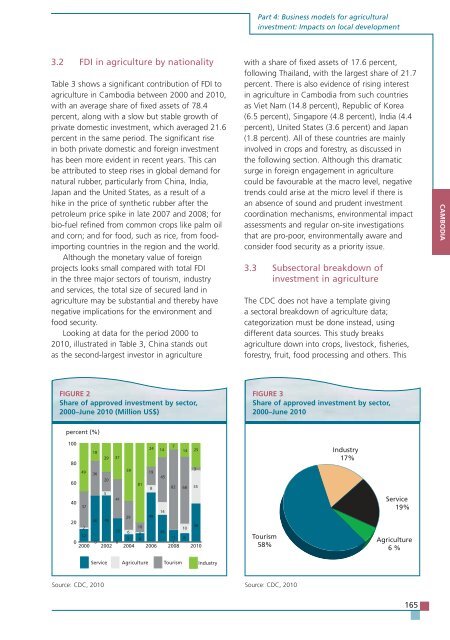TRENDS AND IMPACTS OF FOREIGN INVESTMENT IN DEVELOPING COUNTRY AGRICULTURE
TRENDS AND IMPACTS OF FOREIGN INVESTMENT IN DEVELOPING COUNTRY AGRICULTURE
TRENDS AND IMPACTS OF FOREIGN INVESTMENT IN DEVELOPING COUNTRY AGRICULTURE
Create successful ePaper yourself
Turn your PDF publications into a flip-book with our unique Google optimized e-Paper software.
3.2 FDI in agriculture by nationality<br />
Table 3 shows a significant contribution of FDI to<br />
agriculture in Cambodia between 2000 and 2010,<br />
with an average share of fixed assets of 78.4<br />
percent, along with a slow but stable growth of<br />
private domestic investment, which averaged 21.6<br />
percent in the same period. The significant rise<br />
in both private domestic and foreign investment<br />
has been more evident in recent years. This can<br />
be attributed to steep rises in global demand for<br />
natural rubber, particularly from China, India,<br />
Japan and the United States, as a result of a<br />
hike in the price of synthetic rubber after the<br />
petroleum price spike in late 2007 and 2008; for<br />
bio-fuel refined from common crops like palm oil<br />
and corn; and for food, such as rice, from foodimporting<br />
countries in the region and the world.<br />
Although the monetary value of foreign<br />
projects looks small compared with total FDI<br />
in the three major sectors of tourism, industry<br />
and services, the total size of secured land in<br />
agriculture may be substantial and thereby have<br />
negative implications for the environment and<br />
food security.<br />
Looking at data for the period 2000 to<br />
2010, illustrated in Table 3, China stands out<br />
as the second-largest investor in agriculture<br />
FIGURE 2<br />
Share of approved investment by sector,<br />
2000–June 2010 (Million US$)<br />
percent (%)<br />
100<br />
18<br />
24 14<br />
7<br />
14 25<br />
29 37<br />
80<br />
60<br />
49 36<br />
20<br />
5<br />
59<br />
81<br />
19<br />
8<br />
45<br />
82 68<br />
3<br />
35<br />
40<br />
37<br />
41<br />
20 46<br />
2<br />
12<br />
0 0<br />
2000<br />
14<br />
29 49<br />
46<br />
10<br />
38<br />
10<br />
23 6 2<br />
26<br />
5 8<br />
11 8<br />
0<br />
1<br />
2002 2004 2006 2008 2010<br />
Service<br />
Agriculture<br />
Tourism<br />
Industry<br />
Source: CDC, 2010 Source: CDC, 2010<br />
Part 4: Business models for agricultural<br />
investment: Impacts on local development<br />
with a share of fixed assets of 17.6 percent,<br />
following Thailand, with the largest share of 21.7<br />
percent. There is also evidence of rising interest<br />
in agriculture in Cambodia from such countries<br />
as Viet Nam (14.8 percent), Republic of Korea<br />
(6.5 percent), Singapore (4.8 percent), India (4.4<br />
percent), United States (3.6 percent) and Japan<br />
(1.8 percent). All of these countries are mainly<br />
involved in crops and forestry, as discussed in<br />
the following section. Although this dramatic<br />
surge in foreign engagement in agriculture<br />
could be favourable at the macro level, negative<br />
trends could arise at the micro level if there is<br />
an absence of sound and prudent investment<br />
coordination mechanisms, environmental impact<br />
assessments and regular on-site investigations<br />
that are pro-poor, environmentally aware and<br />
consider food security as a priority issue.<br />
3.3 Subsectoral breakdown of<br />
investment in agriculture<br />
The CDC does not have a template giving<br />
a sectoral breakdown of agriculture data;<br />
categorization must be done instead, using<br />
different data sources. This study breaks<br />
agriculture down into crops, livestock, fisheries,<br />
forestry, fruit, food processing and others. This<br />
FIGURE 3<br />
Share of approved investment by sector,<br />
2000–June 2010<br />
Tourism<br />
58%<br />
Industry<br />
17%<br />
Service<br />
19%<br />
Agriculture<br />
6 %<br />
165<br />
CAMBODIA


